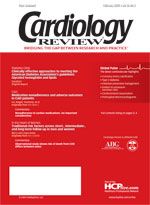Publication
Article
Cardiology Review® Online
High-resolution spiral computed tomography coronary angiography
Author(s):
We evaluated the performance of the 64-slice spiral computed tomography coronary angiography scanner in 52 symptomatic patients with stable sinus rhythm and found that it was highly reliable in ruling out the presence of a significant coronary stenosis. This technique may be regarded as a suitable alternative to invasive coronary angiography.
Multislice spiral computed tomography (MSCT) coronary angiography has recently surfaced as a noninvasive, patient-friendly diagnostic procedure for the detection of hemodynamically significant coronary stenoses.1-13 We evaluated the accuracy of the most recent 64-slice MSCT scanner in the detection of significant coronary stenoses in 52 symptomatic patients.
Patients and methods
We assessed 70 symptomatic, consecutive patients who were referred for diagnostic coronary angiography. All patients had stable sinus rhythm and were able to hold their breath for 15 seconds. After exclusion of 1 patient with an allergy to contrast medium, 4 patients with renal dysfunction, 4 patients with arrhythmia, and 9 patients with logistic problems, 52 patients remained, 34 of whom were men. The patients had a mean age of 59.6 ± 12.1 years.
Prior to the investigation, 1 dose of metoprolol (Lopressor, Toprol-XL) was given to patients with a heart rate above 70 beats per minute (bpm). We used a 64-slice computed tomography (CT) scanner (Sensation 64, Siemens, Forcheim, Germany) with an isotropic spatial resolution at 0.4 mm3, a temporal resolution of 165 ms, and an x-ray tube rotation time of 330 ms. Patients received a bolus of 100 mL of iomeprol (Iomeron 440) contrast medium through an injection into the arm, with a flow rate of 5 mL/s. A retrospective electrocardiogram (ECG)-gated reconstruction protocol was used, and images were reconstructed from data obtained at the mid- to end-diastolic cardiac phase. The radiation exposure during MSCT, defined as the effective dose, was 15.2 to 21.4 mSv.
Quantitative invasive coronary angiography was always performed after the MSCT investigation. The coronary tree was evaluated according to a 16-segment coronary artery model modified from the American Heart Association (AHA) classification.14 A significant stenosis was defined as a decrease in lumen diameter of ≥50%.
Results
lists the characteristics of the participants. A beta blocker was administered to 73% of patients prior to scanning. During CT scanning, the mean heart rate was 60 ± 7 bpm, and the mean scanning time was 13.3 ± 0.6 seconds. One patient was excluded because of an unsuccessful CT scan resulting from bigeminy during scanning.
shows the diagnostic performance of the 64-slice MSCT scanner for the detection of a stenosis ≥50% compared with invasive coronary angiography. All 12 patients who were either normal or who had nonsignificant coronary stenosis were correctly identified using the MSCT scans, but 1 patient was misidentified because the severity of a nonsignificant coronary lesion was overestimated based on the MSCT scan. Significant coronary stenosis was properly identified on MSCT scans for all 38 patients with major coronary artery disease.
Discussion
MSCT coronary angiography has made tremendous strides in recent years and has evolved into a noninvasive high-resolution coronary imaging modality with the potential to become a reliable alternative to invasive diagnostic coronary angiography. The latest generation of 64-slice MSCT scanner evaluated in this study has high spatial and temporal resolution, with isotropic imaging at 0.4 mm3 and a temporal resolution of 165 ms. This has significantly reduced the occurrence of motion artifacts associated with coronary imaging. The 64-slice MSCT scanner now allows evaluation of all 16 segments of the AHA coronary segment model, which was not always possible with the earlier 16-slice MSCT scanner.1-9 Our results in terms of the diagnostic performance of MSCT coronary angiography for the detection of significant stenoses were in agreement with other studies of 64-slice MSCT scanners, which also showed high sensitivities, specificities, and positive or negative predictive values.10-12
Several significant limitations of MSCT coronary angiography still exist, however, even after the introduction of the 64-slice MSCT scanner. Although the 64-slice MSCT scanner is less sensitive to motion artifacts, which are more likely to occur with heart rates > 70 bpm, decreasing the heart rate to < 70 bpm with the administration of beta blockers prior to the CT investigation is still recommended. MSCT coronary angiography cannot be used in patients with irregular heart rhythm, such as those with atrial fibrillation. The effects of minor rhythm abnormalities, such as frequent extrasystoles, can be decreased by manual repositioning of the retrospective ECG-gated reconstruction windows.
An obstinate problem continues to be severe calcification. The blooming artifacts caused by calcification often result in overestimation of the seriousness of an adjacent coronary stenosis, causing misclassification of luminal obstructions, whereas extensive calcification of a plaque obscures the underlying lumen and does not allow evaluation of such a coronary segment. One negative feature of MSCT coronary angiography is the significantly higher radiation dose (21.4 mSv for women and 15.2 mSv for men) compared with diagnostic invasive coronary angiography. Through use of the prospective x-ray tube modulation mode, however, this exposure can be decreased by about 40%. This mode reduces the x-ray tube output during systole and provides full-power x-ray tube output during the diastolic phase, when the data are obtained for reconstruction of the coronary images.
Conclusion
We showed that MSCT coronary angiography can be used instead of invasive diagnostic coronary angiography in selected symptomatic patients with a high prevalence of coronary artery disease who have a stable, low heart rate and absence of severe calcification. In particular, a normal MSCT scan is highly reliable in ruling out the presence of a significant coronary stenosis.






